Over the next months while the Design with the Other 90%: CITIES exhibition is on display at the United Nations Headquarters in New York several individuals whose own research explores the exhibition’s subject matter have been invited to write blog entries sharing their insights, related research and projects. – Cynthia E. Smith, Curator of Socially Responsible Design, Cooper-Hewitt, National Design Museum
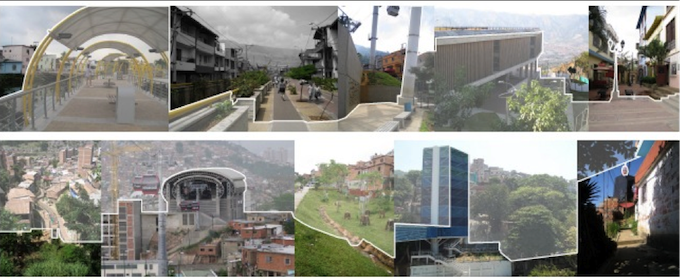
Top left to right: Waterfront Boardwalk Malecón del Salado (Guayaquil); Water Channel and Promenade in Moravia, Park around Metrocable structure in Santo Domingo, Quality School Antonio Derka in Santo Domingo (Medellin); bottom left to right: Restoration of Juan Bobo Creek in Santo Domingo (Medellin); Metrocable (Caracas); Natural Water Spring Restoration and Park in the favela Guarapiranga (Sao Paulo); Elevator in the favela Morro do Cantagalo (Rio de Janeiro, photo credit: Andy Carman); Metrocable Santo Domingo (Medellin)
With the unprecedented increase of informal settlements, or favelas, and a large percentage of the world’s urbanization happening informally, contemporary urban discourses and practices have re-centered their attention on urban informality. Following a long history of tabula rasa, public housing, self-help, and sites-and-services schemes, current approaches to the favela have evolved to strategies characterized as ‘urban acupuncture,’ aiming to minimize displacement while improving conditions in the area. We are now witnessing spectacular libraries in depressed neighborhoods, gondola systems in marginalized areas, and museums in squatter settlements. It appears we have returned to the notion “slums of hope,” 1 no longer vilifying informal settlements but viewing them as integral in the development of the city, thereby reformulating the discourse of the growing city and the relations between global and informal. With design as a central component in the approach, and through interventions that acknowledge and legitimize informality’s architectural and urban potentials, designers and planners have adopted the favela as a new paradigm in the development of the city; a paradigm I call Favela Chic.
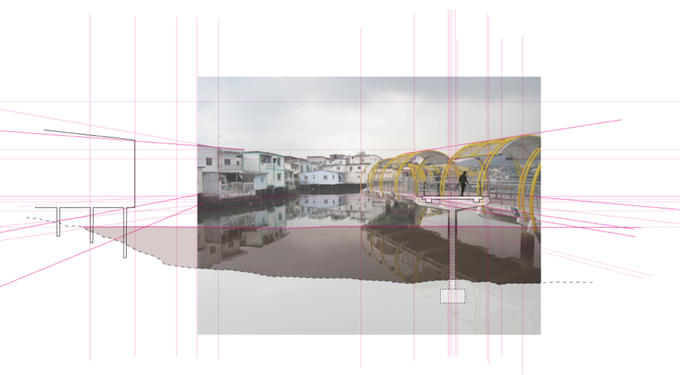
Section diagram of waterfront boardwalk Malecón del Salado, Guayaquil, Ecuador.
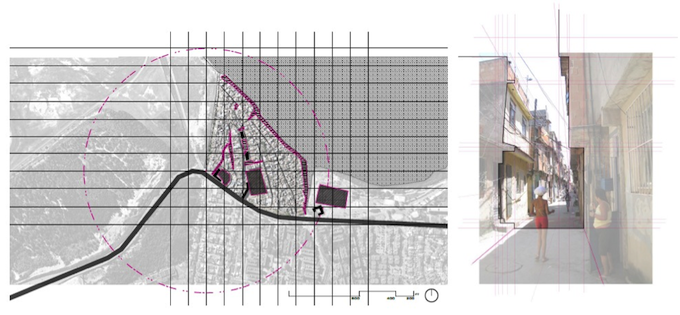
Left to right: Waterfront site plan and intervention diagram; Section diagram through existing urban fabric, favela Parque Royal, Rio de Janeiro, Brazil
Based on comparative empirical work in various countries of Latin America, where some of the most striking efforts to address favelas are taking place, a first part of my research, analyzes the potentials and limitations of current practices in ‘slum upgrading.’ Although current design-centered interventions can be catalysts to claim rights to the city, conversations about key issues, short and long-term outcomes are critical: Why, where and how are these interventions operating?
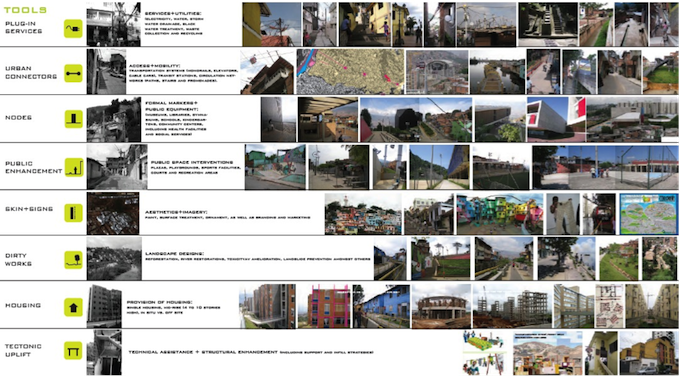
Favela Chic Tools: Acknowledging auto-construction as a legitimate way of providing housing, and seeking instead to minimize displacement and integrate the favela with the city, projects focus on aspects that are most absent in settlements: infrastructure, public space, and public equipment. Although ranging in types and scales, from small acupunctural projects to expansively designed infrastructural networks, I identified seven common architectural tools based on comparative field studies in Latin America.
As a way to record my research observations, analysis, and travels, I began a blog FAVELissues in 2010. More recently, it has transformed into an interdisciplinary platform featuring emergent and prominent practitioners and researchers in the field of urban informality.
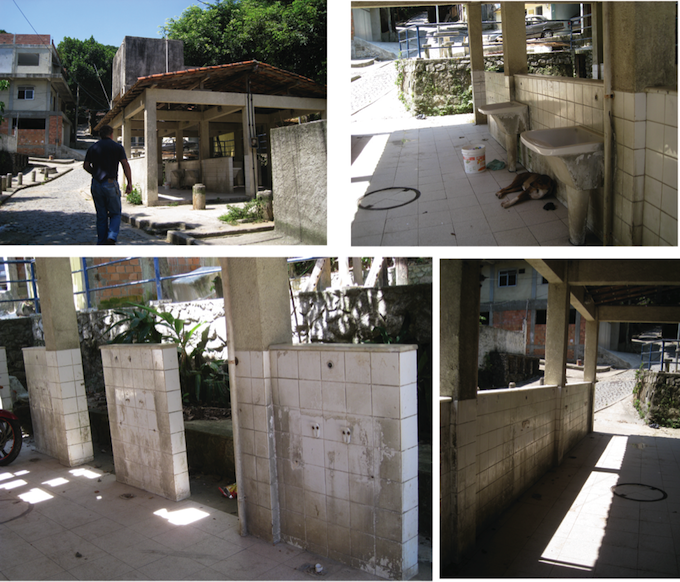
Communal Laundry in the favela Vidigal, Rio de Janeiro, Brazil.
Many interventions failed to recognize internal realities of the area leading to difficult challenges in the long-term sustainability of projects. As a general observation, some of the other major critiques of Favela Chic interventions include: Confused priorities–many of the interventions seen place a great emphasis on aesthetics and representation, overlooking many of the structural issues and recurring problems in the favela; Shortermism–There is a high difficulty in the maintenance and long-term sustainability of projects; Economic outcomes and formal market overlooked–Many interventions disregarding the rise in property values, frequently leading to an absolute formalization, making the system no longer flexible for the residents; Disconnection from the internal logic of the settlement–Many projects use the favela as a backdrop but remain disconnected from the internal needs, use values, and hierarchies of the area.
Expanding on the comparative analysis done, a second component of my research, Rethinking the Favela: Favela Chic to Urban Stitching, focuses on the development of alternative propositions to address urban informality. The goal here is not to establish a set of ‘best practices,’ but to re-evaluate the current standards and practices. Challenging the adoption of an image of social good, and instead encouraging a deeper engagement of cultural specificities and socio-economic realities in each context, the research aims to enable new spatial strategies, policies and political possibilities surrounding the favela. In this manner, the final product, which I am currently working to publish, hopes to further the understanding between design, planning and informality in the workings of an urban project, a commu-nity, and a sustainable and inclusive city. 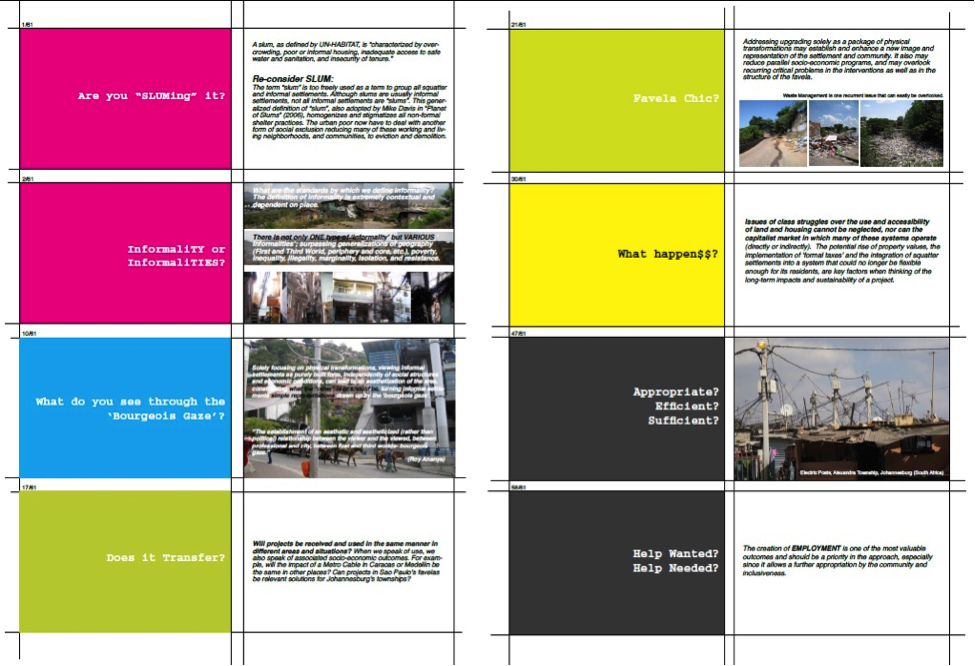
As a first part of the final product, a set of cards contains questions, quotes and observations as well as a background manual and instructions, presenting an alternative systematized approach for the operations and processes of spatial practices in the context of the favela.
Adriana holds a dual Master’s degree in Architecture, and City and Regional Planning from the University of California at Berkeley. Born and raised in Colombia (S.A), she received a BS Arch (Honors) from the University of Virginia in 2004. After working for Rafael Viñoly Architects, and OPX Global in Washington DC, Adriana moved to California to begin her graduate studies in 2007. As a 2010 John K. Branner Fellow, Adriana traveled the world, focusing her research, FAVELA CHIC, on socio-cultural aspects of design, particularly analyzing the role and relationship between architecture, planning and urban informality. Adriana is the founder of the blog www.FAVELissues.com, and she is currently working on publishing her research and thesis.
All image credits: Adriana Navarro-Sertich, unless otherwise noted; for Favela Chic Tools, under Skins + Signs: Painted facades in favela Santa Marta source: www.favelapainting.com, Tourist Map of Medellin source: www.medellin.gov.co, and under Tectonic Uplift, Manufactured Sites Renderings source: Estudio Teddy Cruz 1 Perlman, Janice, “Six Misconceptions about Squatter Settlements,” in Development, Journal of the Society for International –Development, l986: 4, pp. 40-44.